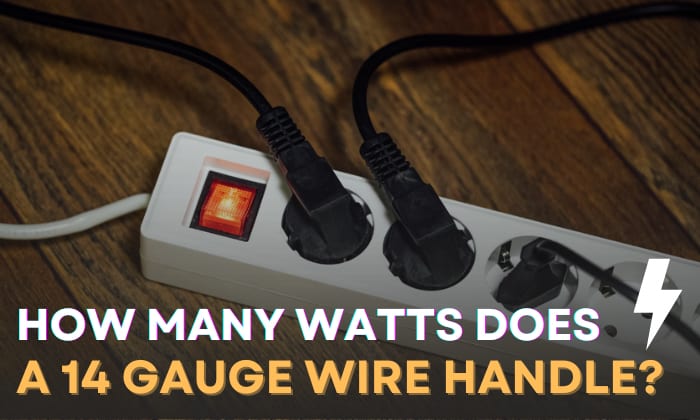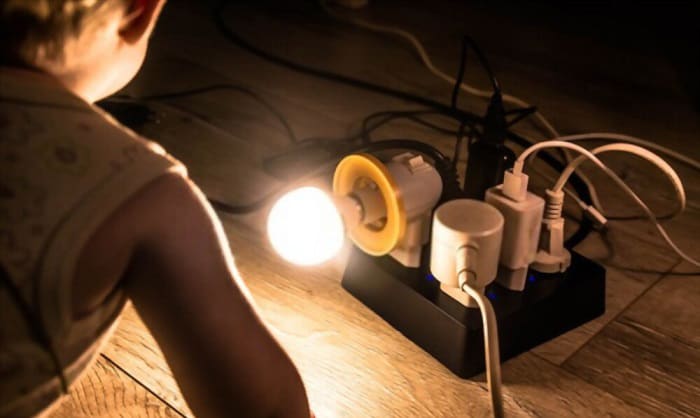Many people wonder, “How many watts can a 14 gauge extension cord handle?” when sizing their cables.
To get a cord’s wattage, we must follow the standard formula: W = V x A. Since 14 gauge cords are rated for up to 15A and mostly 125V, their exact wattage ceiling is 1875W. Some even limit it to just 12A, which means a wattage rating of 1,440W, especially if the cables run for less than 50 feet.
Not every 14 AWG extension cord has the same rated amperage, running length, and voltage, so expect varying wattage limits.
Table of Contents
How Many Watts Does a 14 Gauge Wire Handle?
I’m going to go ahead and assume that you’re asking this question because you want to make sure that you’ll plug the right appliance into your extension cord. Well, a standard 14 gauge extension cord 10 ft is pretty much a solid medium-duty choice.
You can use it for lights with higher-than-normal power draw, and most appliances that don’t pull more than 15A or 1875W. High-wattage devices like coffee makers, window air conditioners, hair dryers, and countertop microwaves are off-limit.
If you’re going for an extension cord with a longer running length (over 50 feet), you may need to consider the next bigger gauge to take care of voltage drops.
More Details Are Necessary
To be clear, wire size is only related to extension cord amperage or how much current the wire can handle without melting. An extension cord rating for wattage pertains more to its overall rated capacity.
As far as extension cords are concerned, the main question is a vague one. We need to know the exact voltage that the extension cord’s ends are rated for to get the exact wattage limit.
In this case, it’s almost always 125V, 120V, or 110V. Don’t be confused by products that have 300V as the alleged voltage.
That only refers to the maximum voltage the cord’s wires can handle and is best left ignored when determining wattage; in most cases, the cord’s ends will have a rating of 125V, and you should go with that measurement instead.
Incidentally, that numerical value technically doesn’t make it a high voltage extension cord since 600V is the ceiling.
Moreover, you’ll see an amp rating of 13A in some extension cords, while others are marked as 15A. This seemingly slight dip in amperage rating has a direct influence on final wattage numbers.
- A 14 AWG 13 amp extension cord will have a limit of 1625W.
- On the other hand, an extension cord with the same wire but rated for 15A will have 1875W as its maximum wattage cap. Note that both of these estimates apply to 125V cords.
- At 110V and 15A, the maximum will be 1650W. This may decrease to 1430W and 770W for wires with running lengths of 100 feet and 150 feet, respectively. Of course, the rated amps will decrease, too (to 13A and 7A).
See how we’re always concerned more about amps to determine the corresponding wattage of a particular wire size? You don’t need to dive into the diameter in mm of a wire to know whether you’re using the correct one or not.
You have to look at the amp rating and voltage first because we can’t get the wattage, otherwise. As you can see, distance also plays a significant role.
You also don’t need an extension cord calculator for this. It’s easy to do the math yourself, then look at the numbers on the extension cord’s specs sheet to confirm.
If they don’t reveal the amp rating and voltage, don’t hesitate to contact the manufacturer to get them. You can even go ahead and ask for the maximum wattage while you’re at it.
I’ve prepared an extension cord gauge chart and wattage chart here for your convenience. These account for the highest amp ratings of the said extension cords, lengths that don’t go over 50 feet, and with a default 110V rating.
| Wire Gauge | Wattage |
| 10 gauge | 2,200W (rated at 20A) |
| 12 gauge | 1,980W (rated at 18A) |
| 14 gauge | 1,650W (rated at 15A) |
| 16 gauge | 1,430W (rated at 13A) |
To confirm these numbers yourself, just multiply the amp ratings with the voltage. Don’t use a wire size calculator, as you may end up with wrong recommendations.
Better yet, just stick to the figures shared by the manufacturer. If they state that your 14 gauge extension cord won’t be able to handle any continuous load over 1,000W, then there’s no reason for you to push that limit. Make sure the suggestions come straight from an official source, though.
FAQs
What is a 14 gauge extension cord good for?
Not counting its running length, a 14 AWG cord should be able to handle medium-duty appliances like laptops, a leaf blower, and most power tools. Technically, feel free to use it with any appliance that doesn’t exceed its maximum amp rating, which is normally 15A.
Once running length becomes a huge factor due to voltage drop, it’s probably time to swap it for the next suitable cord, which is a 12 gauge.
Can I run a refrigerator on a 14 gauge extension cord?
A refrigerator pulls between 15A to 20A. As long as you’re aware that your refrigerator is rated for the minimum, only requires 15A of continuous current, and the cord’s running length doesn’t go over 50 feet, then you can pair your fridge with a 14 gauge extension cord.
Conclusion
Here’s what you need to remember to always quickly know the answer to “How many watts can a 14 gauge extension cord handle?”
- Look at the cord’s amp rating and voltage, then multiply the two to get the specific wattage limit.
- Be mindful of slight deviations in amp ratings, distance, and voltage, if you want to get the most exact figures.
- Use the wattage figures in the table above to get a general idea.

I am Edwin Jones, in charge of designing content for Galvinpower. I aspire to use my experiences in marketing to create reliable and necessary information to help our readers. It has been fun to work with Andrew and apply his incredible knowledge to our content.



